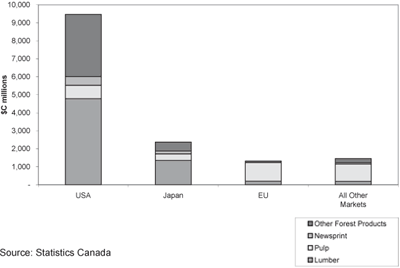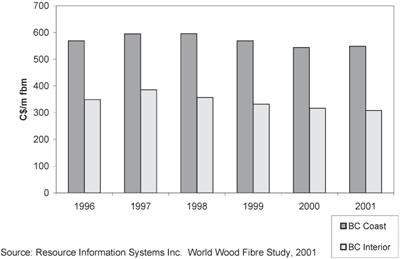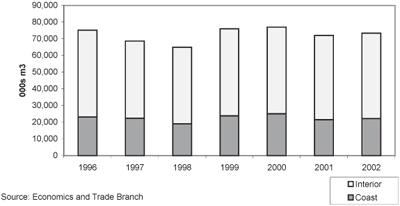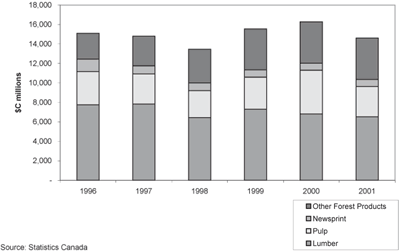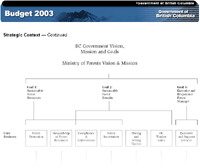 |
|
Strategic ContextMinistry OverviewSince its establishment in 1912 as the Forests Branch, the Ministry of Forests (also known as the Forest Service) has continued to protect the public's interest and provide leadership in the protection, management and use of the province's forest and rangelands. The Forest Service is the main agency responsible for the stewardship of 47 million hectares of provincial forestland. In addition, the ministry provides fire protection services for 84 million hectares. Managing these provincial forests presents a unique and complex set of challenges. More than 90 per cent of BC's forest lands are publicly owned, which means that the provincial government, on behalf of the public, plays a much more prominent role in the forest sector than its counterparts in other forestry jurisdictions. The broad extent of B.C.'s forest lands also means that forestry is a significant contributor to the province's overall economic health. Of the province's 63 regional economic areas, 41% rely on forestry as their principal source of income1. The forest sector is estimated to account for 22% of total provincial employment and nearly 25% of provincial gross domestic product2. The ministry pursues its goals for sustainable forest resources and benefits in a consultative manner with the public, industry, and other Crown agencies, while recognizing the unique interests of aboriginal people.
This consultative and partnership approach to forest management, seeks to earn the public's trust as our staff protect and manage the province's forest and range resources, to ensure that all British Columbians can look forward to healthy forests and a strong forest economy now and in the future. The ministry is proceeding with a new organizational structure (Appendix 2) to be fully implemented by 2004/05. This includes the closure of some offices during 2003/04, and will result in three forest region offices subdivided into 29 forest district offices and 4 satellite offices. The 6 fire centres will remain. In addition, a new BC Timber Sales organization with 12 field offices has been created during 2002/03 and will be managed on commercial principles and at a greater "arms length" from compliance and enforcement decisions. The main legislation for which the Forest Service is responsible is outlined in Appendix 1. The legislation is undergoing significant revisions in 2002/03 in order to meet new government direction. Ongoing revisions, including subsequent changes to regulations, will carry through 2003/04 and 2004/05. Major emphasis in 2003/04 will be on making an effective transition to the new Forest and Range Practices Act, to replace the Forest Practices Code of BC Act.
Highlights of Changes from Previous PlanThe ministry is on track to achieving the key components outlined in the 2002/03 to 2004/05 Service Plan published last year. Changes from last year, now included in this Plan, are:
Planning ContextIntroductionUncertainty and rapid change are ongoing features of the forest sector's global environment. In 2003/04, competitiveness issues are likely to continue to dominate the forest policy agenda, with forest stewardship, market reform policy change and U.S. market access, three key themes. Forest Stewardship The ministry is faced with numerous challenges in managing the large public-land based forest resource. The ministry's Service Plan is intended to address the changing nature of the resource as well as related social priorities, devolution of certain management functions to licensees, and collaboration among government agencies.
Revitalizing the Forest Sector Implementing market-based policy reform will be a focus for the ministry during 2003/04. The purposes of this reform are to create the framework for a competitive, dynamic forest industry and to maximize the contribution of the forest sector to British Columbians standard of living. There are two complementary components to market-based policy reform:
The Ministry will also focus on the implementation of market oriented policy change initiatives announced in 2002/03. U.S. Market Access The softwood lumber dispute with the United States is also a major issue for the British Columbia forest sector.
Prices, Costs and PerformanceB.C.'s forest-based industries produce an array of wood products, but are dominated by the production of lumber, pulp and paper. These commodities are sold into world markets. The ministry's market-based policy reform is focused on supporting a globally competitive forest industry while ensuring that the public receives fair value for its resource. In 2001, the last full year for which data is available, B.C. forest product exports totaled $14.6 billion and accounted for 47 per cent of total provincial exports and approximately 8 per cent of world exports of forest products. Late 2002 results (year-to-date November), indicate that total forest product exports for 2002 will be below 2001 levels due to weak pulp and paper markets. The primary market for B.C. products is the U.S., which imported 65 per cent of B.C.'s total provincial forest product exports in 2001. Japan is the second-largest market, accounting for approximately 16 per cent of exports3. Exports by Destination
The forest sector's reliance on exports means that world prices are an important determinant of the health of the sector as a whole.
Generally, prices were down in 2001 and this trend continued into 2002. The price of spruce-pine-fir (SPF) softwood lumber 2x4s, the key product of the Interior lumber industry, fell from an average of US$255/thousand board feet (mfbm) in 2000 to US$249/mfbm in 2001, a drop of 2 per cent. In 2002, softwood lumber 2x4 prices fell by nearly 6% to an average of US$235/mfbm4. The softwood lumber tariff, and changing U.S. economic conditions have undoubtedly contributed to the decline in lumber prices. The price for hemlock baby squares, a key product for the Coastal industry, was relatively stable in 2001 with prices up over year 2000 results. Average prices increased slightly again in 2002 to an average of US$597/mfbm4. However, Japanese demand is below 1990s levels and is likely to remain so given Japanese economic performance and shifts in product demand. Market demand for northern bleached softwood kraft (NBSK) pulp weakened markedly in both 2001 and 2002. In 2002 NBSK pulp averaged US$463/tonne, down by 32 per cent from the 2000 average of US$681/tonne5. In 2001, newsprint prices increased by 4 per cent with average prices reaching US$588/tonne for the year. This strength was not maintained. Average newsprint prices for 2002 were US$468/tonne, a drop of 20 per cent. However, some analysts suggest that newsprint prices have bottomed out6. Total Variable Costs
Timber Scale Billed
In addition to world prices, production costs are important to the provincial forest sector. For a cyclical, competitive, mature industry to be successful in the global marketplace, costs must be kept low. In 2001, variable costs — or costs that vary directly with output — increased slightly on the Coast, but declined in the Interior. The variable cost category includes costs of harvesting, labour and supply. For a variety of reasons, including the diversity of wood types and terrain, the B.C. Coast has significantly higher lumber production costs overall than the Interior. High production costs, changing markets, and environmental pressures continue to exert significant restructuring pressures on the Coast. B.C. total harvest levels (Crown and private land), as measured by timber scale billed, were down somewhat in 2001, falling from 77 million cubic metres (m3) in 2000, to 72 million m3. Despite trade uncertainty and weak lumber prices, harvest levels rose slightly in 2002 to 73 million cubic metres.7 The general weakness in the sector was also evident in the employment and export numbers. Employment levels in all sub-sectors of the industry dropped in 2001, with the largest fall occurring in the solid wood products category. Total direct employment in the industry was 85,041 positions, a drop of 12 per cent from 2000. Forest sector employment levels have continued to weaken in 2002. As of October, forest industry employment is 20 per cent or more than 17,000 jobs below comparative 2001 levels with all sub sectors posting significant declines.8
Exports by Forest Product
Total British Columbia forest exports dropped from $16.3 billion in 2000 to $14.6 billion in 2001. Reduced pulp shipments accounted for much of the change. Based on information from eleven months of the year, similar results are expected for 2002. The pulp and paper sector has remained weak with the result that pulp and paper product exports are below 2001 levels. Solid wood exports may decline slightly.9
Supply and SustainabilityWhile demand-side issues have been centre of attention for the past few years, any economic scan of our forest sector is incomplete without an examination of timber supply. Two supply-related issues that will affect the provincial forest sector on a long-term basis are:
World Timber Supply World timber supply is not expected to be a constraint on global forest product production in the foreseeable future. It is expected that the availability of wood fibre will improve significantly over the next 20 to 25 years, as the commercial production of timber becomes increasingly concentrated on managed forests and plantations10. While timber inventories in global "native" forests are expected to decline moderately, "non-native" plantation inventories will more than compensate for the loss. Both economic and environmental factors are responsible for reshaping the world's fibre supply. From a production prospective, non-native plantations are generally more productive than their native counterparts, and many countries have actively encouraged investment in this type of forest resource. Simultaneously, there has been increasing international pressure for the conservation of "native" forests due to concerns about deforestation and forest degradation. Indeed, globally, B.C.'s forest resource is increasingly unique. For example, B.C.'s remaining old growth Coastal rainforest represents approximately 25% of the remaining coastal temperate rainforest worldwide. By 2025, some experts predict that fibre from "non-native" plantation inventories will represent one-third of the operable growing stock and supply more than half of global wood fibre needs. In terms of wood supply, this means that Asia, Central America, South America, Australia and New Zealand will become increasingly important wood-fibre suppliers. From a B.C. perspective, this likely implies increased competition in world forest product markets and increased pressure for the conservation of increasingly rare forest types.
Sustainability Certification is increasingly seen as a means of sustainable resource management and excellence in forest stewardship. It is expected that, over time, certification will become more of a prerequisite for access to global forest product markets. Virtually every major B.C. forest company has either achieved or is pursuing third-party certification. First Nations Land ClaimsThe uncertainty associated with unresolved First Nations land claims continues to affect the provincial forest sector. Recent court decisions have reinforced the importance of consultation with and accommodation of First Nations interests. It will take time and experience to adequately sort out the roles and responsibilities of government, industry and First Nations in this regard. It is expected that as land claims are resolved and treaties are put into place, there will be increased stability for forestry operators on the land base. In the meantime, the Ministry will continue to consult with First Nations on forest management activities in order to meet its legal responsibilities to First Nations. ConclusionThe B.C. forest sector will continue to face the challenges associated with a dynamic and ever-changing global environment. Only a sector that is outward looking, globally competitive, environmentally responsible, and locally accountable will be able to succeed. The ministry's ongoing task is to ensure that an appropriate policy, regulatory and legislative framework is in place to support these objectives. Ministry of Forests (Forest Service) Vision:Healthy Productive ForestsThe province of British Columbia is renowned for its rich and diverse forest and range resources, more than 90% of which are publicly owned. These resources are a major source of environmental, economic and social benefits, contributing to a high standard of living for individuals and communities across British Columbia. Healthy, productive forests are the cornerstone from which all other forest benefits are possible, including continuous generation of substantial revenue to the Crown. The Forest Service, as the agency responsible for protecting and managing these resources, will focus on ensuring that the health and productivity of the province's forest and range resources are maintained now and in the future. Healthy forests include a diversity of ecosystems that support a full range of forest products, businesses and other opportunities. Forest Service Mission:Protect and manage our public forests for the sustained benefit of all British Columbians.Since its establishment in 1912, the Forest Service has been mandated to protect and manage the public's forest and range resources. We have recently adopted the motto "Stewards of Our Forests" to reflect this mandate. Other roles have come and gone, but the stewardship role continues to be the foundation of our organization and is reflected in our mission statement. The key responsibilities for the Forest Service in undertaking this mission in the future are:
We will carry out this mandate in co-operation with our other public and private sector partners. To fulfil this mission, the establishment of clear policies and scientifically-based standards to protect the province's forest and range resources are required to ensure a full range of benefits are available from these resources on a sustainable basis. The Forest Service will continue to monitor and enforce standards for the forest and range practices carried out by licensees. At the same time, we will implement pricing and selling policies aimed at making the province's forest sector more competitive in global markets, and ensuring the Crown receives fair value for the use of its forest and range resources. Values and EthicsIn carrying out our mission and day-to-day activities, the people of the Forest Service share the following core values and ethics: Values:
Ethics:
Linking the Strategic Context with the structure of the Service PlanThe Forest Service has three long-term goals to provide overall direction in achievement of its mission and vision. The ministry has established seven core business areas to structure the objectives, strategies and performance measures of the ministry. Each of the Ministry's seven core businesses is linked to at least one of the three goals. Two core businesses, Compliance and Enforcement and Forest Investment support two of the three goals.
|
||||||||||||||||||||||||||||||||||||||||||||||||||||||||||||||||
|
|||||||||||||||||||||||||||||||||||||||||||||||||||||||||||||||||
